Kitchen Project #52: Roasted garlic potato tatin
Roasted garlic butter laminated pastry let's go
Hello,
Welcome to today’s edition of Kitchen Projects. It’s so wonderful to have you here.
Today we are continuing our journey of puff pastry - I’m thrilled to be sharing one of the secret weapons of the pastry world with you: compound butters. This is a real way to unlock flavour in your bakes, especially via lamination. We’ll be making a roasted garlic laminated tart tatin ft. potatoes - it’s knock-your-socks-off delicious and I can’t wait for you to try it.
Over on KP+, I’m sharing the recipe for Cacio e Pepe puff croutons - an adorable way to use up your scraps of puff pastry - as well as my go-to tomato soup recipe. KP+ is the paid version of this newsletter. Subscribing to KP+ costs just £5 and you get loads of extra content + get to support the newsletter so click here to check it out:
Lots of love
Nicola
Double carb, double joy
Since we are already locked into puff pastry, it seems sensible for us to explore some of the other fantastic things we can do with it. And you know me: I love carb on carb. So this week I had my mind set on the world of potato pies. Flaky, buttery puff pastry with the yielding bite of a perfectly cooked spud? Yes please.
Sometimes with recipe development, you have to take a bit of a scattergun approach. The ultimate potato pie? There are just so many directions to go. Ultimately, I decided it was between a creamy gratin style filling or something more crispy and caramelised.
For the creamy cheesy pie, I made two fillings: The first, a classic dauphinoise which is built, cooked and baked without the pastry then transferred and rebaked inside the pastry. The second was a less traditional creme fraiche & comte béchamel. I stirred raw onions and potato slices into it then transferred into a mould and left in the freezer until it was firm. I then wrapped this inbetween puff pastry sheets and sealed and baked. The results? Both delicious but to be honest, a little boring.
For the tatin, I boiled baby potatoes whole then left to cool. Trying to be traditional, I then made a caramel and deglazed with a little vinegar and butter then laid the potatoes, cut side down, followed by thyme and onions. I then draped puff pastry over the top and baked until golden. The result? Erm.. kind of gross honestly. I LOVE caramel, but caramel plus waxy potatoes? It really doesn’t work for me. Much too sweet. Freaky. Instead of caramel compounds, I decided to focus on the maillard reactions of the potato for round 2. I sauteed the potatoes in butter until golden, then added the onions and thyme, followed by a quick grating of comte to hold it all together, before laying the puff pastry on top and baking until golden. The result? Heaven - a true marriage of beautiful flavours.
The only thing it was missing was a shiny top - so, for my final test I mixed up a glaze of honey and mustard and brushed on top. Problem solved and potato pie nirvana reached:
Although I was pretty sure going into this week that I’d be sharing a super creamy cheesy pie with you, it’s going to be all about the tatin. Plus I have a secret weapon to share with you, which we’ll discuss next.
The glory of compound butters
To really push this potato pie to the next level, I wanted to do something extra special to meld it all together: Enter the compound butter.
I know you guys already know what compound butters are - I’m sure you’ll have mixed one up before but to recap, it’s butter + delicious stuff, mixed and formed back together. Compound butters are most commonly used for finishing steaks, fish or veg, or making garlic bread (honourable work), but I think compound butters are one of those secret pastry chef weapons.
Over a year ago, in the cocoa puff edition, I promised to go into further detail about compound butters and I’m delighted that today is the day. This is the first day of your limitless-possibilty-compound-butter-life!
As you know, when we make a laminated pastry, the butter melts in the hot oven which creates steam. The steam provides the lift and leavening between the layers, resulting in flaky layers, but the dough itself is enriched by the melted butter, too.
So, if we are enriching the pastry with the butter, flavouring the whole pastry, why not take this wonderful opportunity to flavour and season the pastry literally from within? A flavour agent on the inside. I’ve loved experimenting with this over the years - from a spicy nduja butter, to a wild garlic butter (turned my pastries green), to a citrus butter - and the results are always next-level flavour sort of stuff. Let’s go deeper.
Butter temps and results of compound butters
There’s really no limit to what you can flavour your butter with, but there are several things to consider:
A compound butter can be more difficult to work with since we are literally disrupting the structure - it wont behave as normal
Butter is a sort of naturally occuring emulsion - fat globules (80-82%) and milk solids (1-2%) with water (15-16%) trapped inside
This allows the butter to behave differently at various temperatures:
6c - Straight from the fridge, the butter is extremely firm and hard. It will splinter when pressed
12-14c - The butter is cold but begins to be ‘plastic’ or ‘bendy’. This is the perfect temperature for laminating as it doesn’t smear
18-22c - The butter is soft and can be easily whipped and agitated whilst having enough structure to retain air
28c - At this stage, butter begins to melt and the emulsion is broken
As you add aromatic components to butter, you are physically disturbing the fat/solids/moisture structure
The chunkier your compound, the more difficult it becomes to work with. When you are rolling out butter these chunks can disrupt the structure - as the butter stretches out, it will be interrupted. This is where the compound butter can become a trade off situation - the compound butter is more likely to split/splinter
As a result, doughs laminated with chunky compound butters might not have quite as ‘fine’ or neat lamination due to the physical interruption of the layers from solids, like herbs or garlic, however you still get a glorious flaky and extremely flavourful and often visually appealing product
To mitigate this, you should try to keep the basic structure of the butter relatively similar - this means adding a lot of moisture (like a fruit puree) is not recommended
The amount of ‘compound’ you add will depend on what you are making. This means you need to consider the quantity of fat overall. For example, if you are using 10% fresh herbs to butter, your recipe will have 10% less fat. So, I like to rebalance my recipes and tend to use more compound butter than plain butter when laminating
If you can mix the aromatics into the dough, it’s worth considering. That being said, I find the flavour imparted by compound butter via melting in the oven is much more intense and perfumed and worth the extra work
Compound butter ideas
Although we’re doing something chunkier today, the absolute easiest way to flavour your butter is using spices since they minimally disrupt the functionality of the butter. Here’s a few ideas to get you started:
Speculoos butter
Chai spice butter
Paprika butter
Coffee butter
Malt powder butter
Zest butter
Roasted garlic compound butter
For this week’s recipe, we’ll be making a garlic butter to laminate our puff pastry with. But not just any garlic butter - roasted garlic butter. When you roast garlic cloves (or confit them - slowly cook them - in oil), the astringent garlic transforms into something mellow, sweet, golden and spreadable.
As garlic is heated, the intense allicin compounds - which are responsible for the pungent garlic aromas - break down, which converts the flavour and texture. The cloves can literally be squeezed out into dishes, or straight onto hot toasted baguette.
We’ll be roasting garlic heads whole with a little oil and wrapped in foil to prevent scorching, then squeezing almost a whole head of garlic and combining with butter before laminating into puff pastry. Since the garlic is soft, it easily incorporates into the butter. As well as this, the garlic has lost water during the roasting so doesn’t create too much havoc. We’ll be using around 20g garlic per 100g butter - 20%.
I don’t have access to a food processor at the moment, so I’ve been mashing the garlic with a fork then combining with soft butter. This results in a slightly more chunky garlic butter, with visible streaks of garlic visible in the final dough and although the pastry does lift beautifully, it doesn’t reach the same height as a standard puff pastry. If you have a food processor, you could blitz the butter and garlic together to make a more homogeneous compound. Either way, the soft compound butter is then spread into parchment paper and chilled until ready to use.
If you’ve made my recipes before, you’ll know I tend to favour making the butter block for lamination just before wrapping it inside the dough, since I think it prepares the butter to the perfect consistency. Unfortunately that doesn’t work as well for compound butters. So, to achieve good plasticity, simply roll the compound block back and forth until it can be easily bent:
Spud love + a little background on potato science
Much like apples, there are many varieties of potato. Although the UK’s most famous crop, the jersey royal, are harvested in March, there is plenty to be excited about all year round.
The most important thing to know about potatoes is to discern between the ‘waxy’ and ‘floury’ camps. Firstly, all potatoes begin their life as waxy potatoes (hence most small potatoes are waxy!): As potatoes grow, the sugars are converted into starch. Different varieties convert different amounts of sugar into starch, resulting in quite different final products. As well as this, there are two different types of starch: Amylose and Amylopectin.
Unsurprisingly (pectin sound familiar?) Amylopectin is the starch that gets sticky and gels in the presence of water, whilst Amylose breaks down completely. The starch in waxy potatoes is predominantly Amylopectin, whilst the starch in floury potatoes is a mix.
So this means that waxy potatoes, like new potatoes, pink firs, la ratte, fingerlings and generally red skinned potatoes, which are comparatively lower in starch (and have very little amylose), can hold their shape over long periods of cooking, resulting in fudgy textures. Floury potatoes, like King Edwards or Russets, are the opposite. Since they are high in the Amylose starch, they break-down as they cook as the cell walls collapse. This makes for ultra fluffy textures.
Of course, there are also potatoes that are somewhere in the middle - life is full of grey areas, isn’t it? But I normally find each potato is closer to one or the other.
So, how do you spot them when you’re out and about?
Well, waxy potatoes tend to be small with thin light or red skin and when you cut it open, it has a very smooth texture - the long thin potatoes also tend to be waxy. Floury potatoes tend to be larger and may have thicker skin. As well as this, if you cut one open, you’ll be able to see more of a texture indicating lots of starch.
Cooking the potatoes
For todays recipe, we’ll be boiling our potatoes in a *rather intense* amount of salt. Much like pasta, you need to salt the water heavily to properly season them. Potatoes are quite a lot fatter than pasta though, so you’ll have to up the salt content accordingly. As well as this, we’ll add some bay leaves into our water - this will also help season the potatoes properly from within.
Using shop bought puff
Wanna make this recipe with shop bought puff? Go for it! But if you do this, please add the roasted garlic cloves into the onions instead, so you don’t miss out on that flavour.
Alright, let’s make it.
Roasted garlic x crispy potato tatin
Before making this recipe, I suggest reading/watching the GIFs from the Kitchen Project Puff Pastry 101 newsletter.
Makes 1 x large 8-inch tatin, serves 6
Roasted garlic ingredients
1 x garlic bulb (or do more, you’ll def eat it all)
1-2 tsp olive oil
Garlic compound butter
20g roasted garlic cloves (around 5-6)
110g soft butter
Roast garlic puff pastry
130g bread flour
5g caster sugar
3g salt
½ tsp vinegar
55g water
40g butter
All garlic compound butter from above
Potato tart tatin ingredients
300g waxy, small potatoes, like new potatoes, charlottes, la ratte or pink firs
60g table salt (!) dissolved in 1300ml boiling water
2-3 bay leaves
1 x large yellow onion, sliced thin
30g comte or parmesan, grated
½ tsp fresh thyme
10g-15g butter for frying
1-2 Tsp olive oil for frying
Honey mustard glaze
50g honey
15g dijon mustard
½ tsp maldon salt
Roasted garlic method
Pre-heat oven to 180c
Remove outer layers of papery skin but leave garlic bulb in tact
Slice off the top of the garlic, revealing the cloves
Place in foil and drizzle olive oil then close foil around clove
Roast for 45 minutes then check - my oven is really slow at the moment, so it actually took 1h15 until they were golden! Yours may be done already. Just check visually - it should be golden and soft and squishy. You can’t really over-do it!
Leave to cool completely
Garlic compound butter method
Squeeze 20g of garlic cloves into a bowl and mash
Add the softened butter and combine completely - try to get it as homogenous as possible
Scrape the butter onto greaseproof paper then close the paper in a rectangle around it, approx 15cm x 20cm
Leave to chill completely
You can also do this in a food processor
Detrempe (by hand - you can also do this in the Kitchen Aid) method - check puff pastry 101 newsletter for GIFs
Put all of your dries into a bowl and mix
Breadcrumb the soft butter into the dries using your finger tips
Create a well in the middle of your dries and slowly pour in the water bit by bit, mixing with a fork so you are combining the liquid/dries carefully
Once everything is combined, turn onto your work surface squish together until just combined - don’t overwork at this stage
Pat into a square, wrap (I like to use a sandwich bag) and rest in the fridge for at least 2 hours
Locking in your butter
Roll your detrempe so it is double the width of your butter block. Use your butterblock to measure the size. You want the edges to be able to fold back over and cover the block completely
As we have made our butter block in advance, roll back and forth on it several times so it is pliable and bendy (GIF in ‘roasted garlic) section
When you are satisfied it is the right size, unwrap the butter and stick it into the middle of your dough. Bring the edges in and pinch it together in the middle. Your butter is now in!
Now press your dough with the rolling pin to help spread the butter out properly then roll your dough out long. Mine is approx 50cm x 20cm. You’re now ready to laminate
Lamination.
Now it’s time to laminate. I have chosen to do 3 x double turns - roll your dough out to triple its length then fold each end to meet, then fold over again like a book. Don’t forget to brush off excess flour:
I leave it at least 1 hour between folds, and then I rest for at least 2 hours before rolling out to allow the gluten to rest and to limit spring back from the gluten being too pumped.
The final roll out
Roll out your pastry to 3mm thickness then put back into the fridge to rest for 20 mins to chill before cutting
Cut a 8.5 inch circle and set aside in the fridge. I like to go slightly bigger than the size of the tin for my tatins
Potato / filling method - potato prep
Bring 1.3l water to simmer then dissolve salt and add bay leaves
Add whole small potatoes into water and simmer for 20 minutes until completely soft
Drain and leave to cool
This can be done ahead of time and potatoes stored in the fridge for 3 days
When ready to cook, halve potatoes longwise
Potato / filling method - onion prep
Slice onion thinly, as thin as you can
Heat olive oil in a sauce pan and throw in your onions with a pinch of salt
Turn the heat down and put a lid on the sauce pan - this allows the onions to steam and go soft
Cook for about 20 minutes until really soft - not caramelised in anyway - but soft and yielding
Leave to cool. You can do this ahead of time and leave in the fridge for 3 days
Potato tatin - final assembly method
Pre-heat oven to 200c fan
Melt butter in a pan - the same pan you’ll be baking in, if possible - and once foaming add in halved potatoes, wiggly piggly style looks good!
Keep on a medium heat for about 10 minutes until the potatoes are lightly golden - keep checking! You don’t want to go too dark here as they will continue to cook in the oven - light golden is perfect
Take off the heat and sprinkle thyme all over the potatoes, followed by the onions - spread and fill in any gaps
Sprinkle grated cheese all over then press the disc of garlic puff pastry on top and stab a few vent holes
Bake for 15 minutes then reduce temp to 175c fan and bake until golden and risen, around 15 minutes
Meanwhile warm the honey and mustard together then whisk in the salt. Set aside
Flip over and brush with the honey glaze. Serve immediately (although you can make it in advance and reheat) - I think salad leaves dressed with an ultra sharp vinaigrette is perfect
Got scraps? Learn how to turn your puff into gloriously flaky cacio e pepe croutons, with a superb tomato soup recipe, over on KP+!

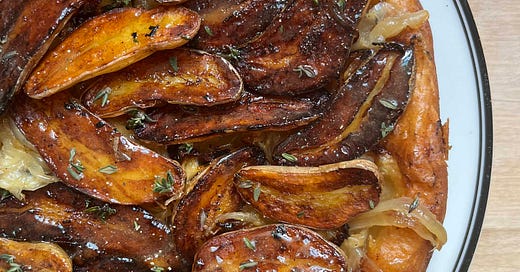



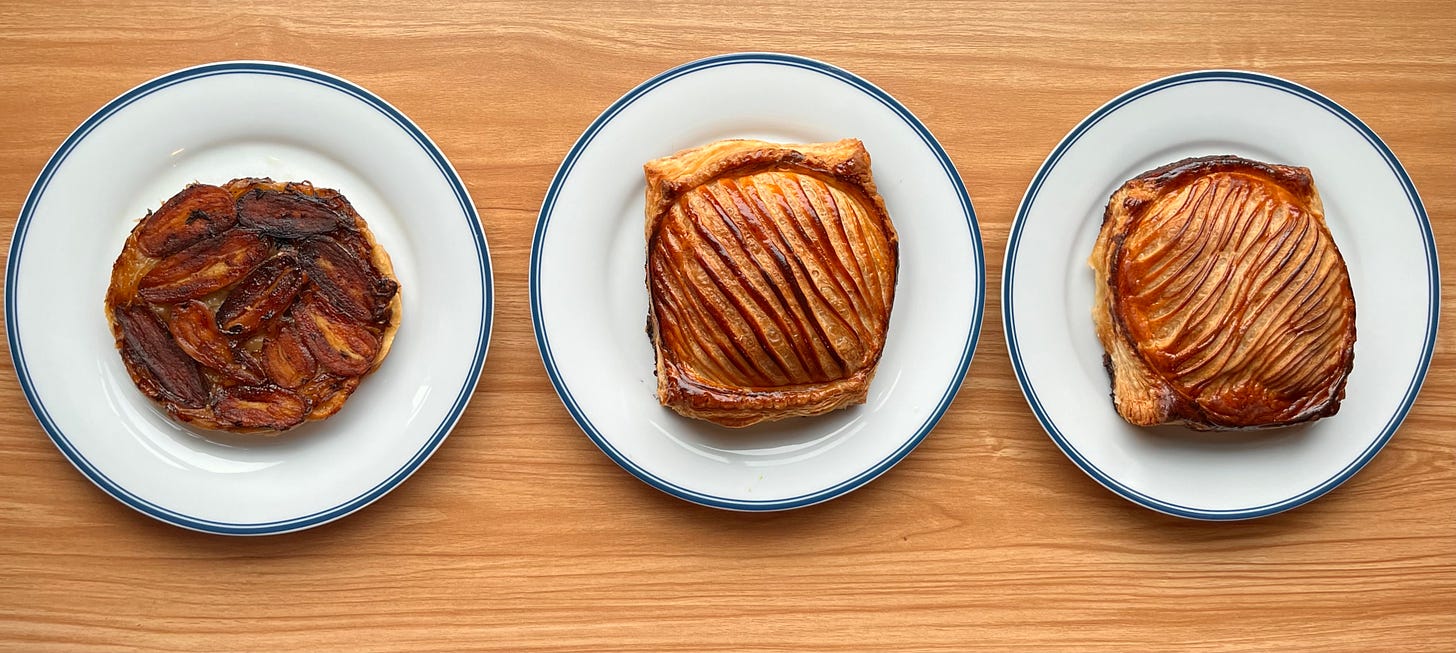

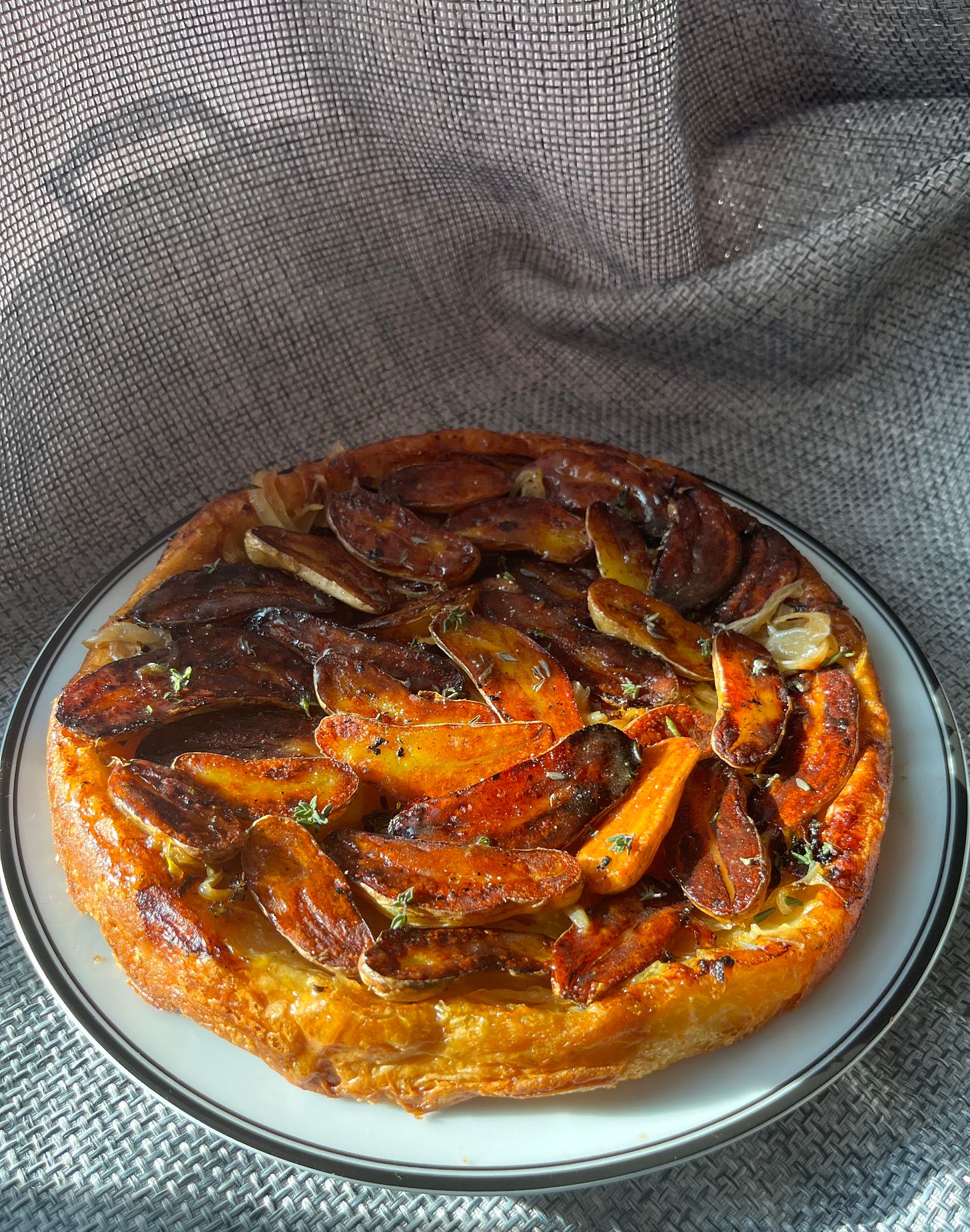

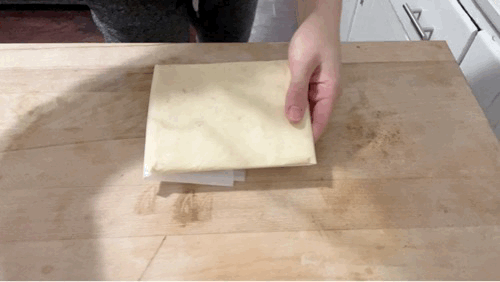



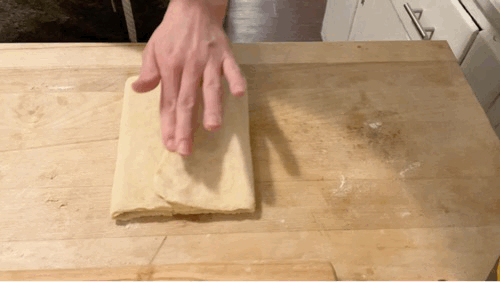

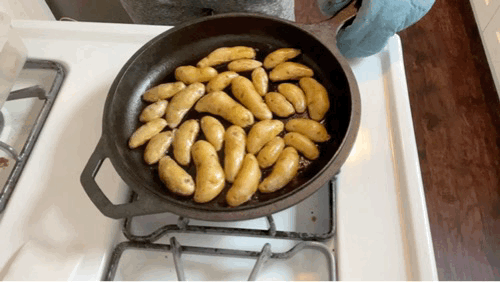


This is today’s weekend project. Super excited to make it. I’m wondering if I wanted to make the puff without the roasted garlic, should I up the butter?